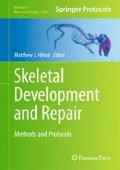Abstract
Osteoclasts are the only cell type in the body to resorb bone. Osteoclasts play a critical role in physiologic and pathologic bone remodeling. Many genetic mouse models affect the skeleton by regulating osteoclast function directly or indirectly. This protocol describes a procedure for generating osteoclasts from mouse bone marrow cells using macrophage colony stimulating factor and receptor activator of NF-κB ligand.
Access this chapter
Tax calculation will be finalised at checkout
Purchases are for personal use only
References
Allen TD, Testa NG, Suda T, Schor SL, Onions D, Jarrett O, Boyde A (1981) The production of putative osteoclasts in tissue culture—ultrastructure, formation and behavior. Scan Electron Microsc:347–354
Ibbotson KJ, Roodman GD, McManus LM, Mundy GR (1984) Identification and characterization of osteoclast-like cells and their progenitors in cultures of feline marrow mononuclear cells. J Cell Biol 99:471–480
Roodman GD, Ibbotson KJ, MacDonald BR, Kuehl TJ, Mundy GR (1985) 1,25-Dihydroxyvitamin D3 causes formation of multinucleated cells with several osteoclast characteristics in cultures of primate marrow. Proc Natl Acad Sci U S A 82:8213–8217
Lacey DL, Timms E, Tan HL, Kelley MJ, Dunstan CR, Burgess T, Elliott R, Colombero A, Elliott G, Scully S et al (1998) Osteoprotegerin ligand is a cytokine that regulates osteoclast differentiation and activation. Cell 93:165–176
Wong BR, Rho J, Arron J, Robinson E, Orlinick J, Chao M, Kalachikov S, Cayani E, Bartlett FS 3rd, Frankel WN et al (1997) TRANCE is a novel ligand of the tumor necrosis factor receptor family that activates c-Jun N-terminal kinase in T cells. J Biol Chem 272:25190–25194
Bradley EW, Oursler MJ (2008) Osteoclast culture and resorption assays. Methods Mol Biol 455:19–35
Yamashita T, Yao Z, Li F, Zhang Q, Badell IR, Schwarz EM, Takeshita S, Wagner EF, Noda M, Matsuo K et al (2007) NF-kappaB p50 and p52 regulate receptor activator of NF-kappaB ligand (RANKL) and tumor necrosis factor-induced osteoclast precursor differentiation by activating c-Fos and NFATc1. J Biol Chem 282:18245–18253
Li P, Schwarz EM, O’Keefe RJ, Ma L, Looney RJ, Ritchlin CT, Boyce BF, Xing L (2004) Systemic tumor necrosis factor alpha mediates an increase in peripheral CD11bhigh osteoclast precursors in tumor necrosis factor alpha-transgenic mice. Arthritis Rheum 50:265–276
Acknowledgements
This work was supported by research grants from the National Institutes of Health PHS awards (AR48697 and AR53586 to L.X., AR 43510 to B.F.B).
Author information
Authors and Affiliations
Editor information
Editors and Affiliations
Rights and permissions
Copyright information
© 2014 Springer Science+Business Media, LLC
About this protocol
Cite this protocol
Xing, L., Boyce, B.F. (2014). RANKL-Based Osteoclastogenic Assays from Murine Bone Marrow Cells. In: Hilton, M. (eds) Skeletal Development and Repair. Methods in Molecular Biology, vol 1130. Humana Press, Totowa, NJ. https://doi.org/10.1007/978-1-62703-989-5_23
Download citation
DOI: https://doi.org/10.1007/978-1-62703-989-5_23
Publisher Name: Humana Press, Totowa, NJ
Print ISBN: 978-1-62703-988-8
Online ISBN: 978-1-62703-989-5
eBook Packages: Springer Protocols

